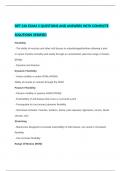Exam (elaborations)
DPT 540 EXAM 2 QUESTIONS AND ANSWERS WITH COMPLETE SOLUTIONS VERIFIED
- Course
- Institution
DPT 540 EXAM 2 QUESTIONS AND ANSWERS WITH COMPLETE SOLUTIONS VERIFIED Flexibility - The ability of muscles and other soft tissues to relax/elongate/lenthen allowing a joint or series of joints smoothly and easily through an unrestricted, pain-free range of motion (ROM). - Dynamic and Passive Dy...
[Show more]



